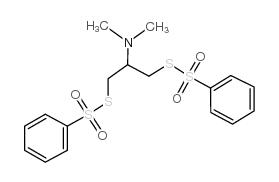bensultap

bensultap structure
|
Common Name | bensultap | ||
|---|---|---|---|---|
| CAS Number | 17606-31-4 | Molecular Weight | 431.61300 | |
| Density | 1.353g/cm3 | Boiling Point | 590.8ºC at 760mmHg | |
| Molecular Formula | C17H21NO4S4 | Melting Point | 82 - 83ºC | |
| MSDS | Chinese | Flash Point | 311.1ºC | |
| Symbol |


GHS07, GHS09 |
Signal Word | Warning | |
| Name | bensultap |
|---|---|
| Synonym | More Synonyms |
| Density | 1.353g/cm3 |
|---|---|
| Boiling Point | 590.8ºC at 760mmHg |
| Melting Point | 82 - 83ºC |
| Molecular Formula | C17H21NO4S4 |
| Molecular Weight | 431.61300 |
| Flash Point | 311.1ºC |
| Exact Mass | 431.03500 |
| PSA | 138.88000 |
| LogP | 5.32240 |
| Vapour Pressure | 6.22E-14mmHg at 25°C |
| Index of Refraction | 1.62 |
| InChIKey | YFXPPSKYMBTNAV-UHFFFAOYSA-N |
| SMILES | CN(C)C(CSS(=O)(=O)c1ccccc1)CSS(=O)(=O)c1ccccc1 |
| Storage condition | 0-6°C |
CHEMICAL IDENTIFICATION
HEALTH HAZARD DATAACUTE TOXICITY DATA
MUTATION DATA
|
| Symbol |


GHS07, GHS09 |
|---|---|
| Signal Word | Warning |
| Hazard Statements | H302-H410 |
| Precautionary Statements | P273-P501 |
| Personal Protective Equipment | dust mask type N95 (US);Eyeshields;Gloves |
| Hazard Codes | Xn: Harmful;N: Dangerous for the environment; |
| Risk Phrases | R22 |
| Safety Phrases | S60-S61 |
| RIDADR | UN3077 9/PG 3 |
| RTECS | DB8000000 |
| HS Code | 2930909065 |
| HS Code | 2930909065 |
|---|---|
| Summary | 2930909065 s-(2-(isopropylthio)ethyl) o,o-dimethyl phosphorodithioate |
|
[Experimental studies on antidotes for the insecticides bancol and nereistoxin acute poisoning].
Zhonghua Yu Fang Yi Xue Za Zhi 21(3) , 149-51, (1987)
|
|
|
[Detection of bancol for the purpose of forensic chemical expertise].
Sud. Med. Ekspert. 53(6) , 39-41, (2010) Optimal conditions for the extraction of bancol from the biological material with toluene are described. The possibility of its purification and separation from co-extracted compounds on a silicagel L... |
|
|
[Detection of bensultap (bancol) derivatives and metabolites by chromatographic methods].
Sud. Med. Ekspert. 52(5) , 30-5, (2009) This paper is designed to describe methods for the detection of derivatives and metabolites of the insecticidic agent bancol (nereistoxin precursor) by chromatographic methods including thin layer chr... |
| MFCD00210246 |
| 1,3-bis(benzenesulfonylsulfanyl)-N,N-dimethylpropan-2-amine |
| S,S’-[2-(dimethylamino)-1,3-propanediyl] di(benzenesulfonothioate) |
| Nereistoxin dibenzenesulfonate |
| Bensultap |
| ZZ-Doricida |
| Ruban |
| Bensultap [BSI:ISO] |
| 1,3-Bis-(benzolsulfonylthio)-2-dimethylamino-propan |
| S,S’-[2-(dimethylamino)propane-1,3-diyl] dibenzenesulfonothioate |
| 1,3-bis(benzenesulfonylthio)-2-(N,N-dimethylamino)propane |
| TI-78 |
| Victenon |
| S,S’-2-dimethylaminotrimethylene di(benzenethiosulfonate) |
| Bancol |
| S,S'-[2-(dimethylamino)trimethylene] bis-benzenethiosulfonate |
| ZZ-Doricida Insecticide |